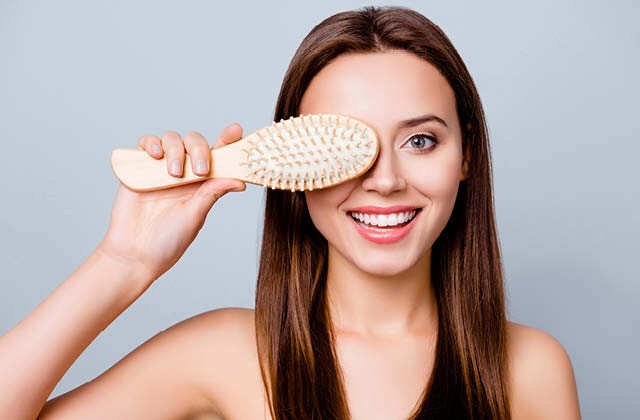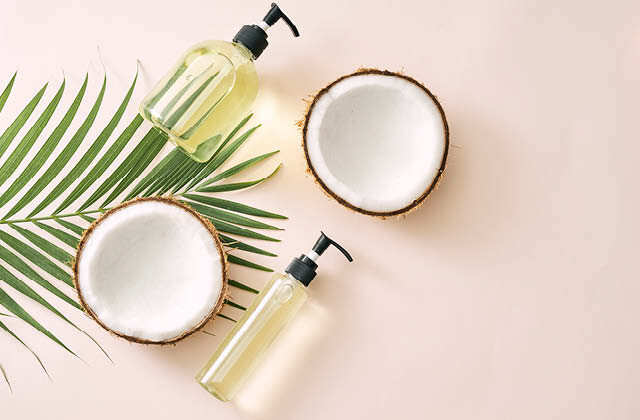In the beauty industry, everyone seems to have a story when it comes to hair problems. No matter what the story, the ultimate goal is healthy, great-looking hair. Here are 10 common hair problems and the best ways to overcome them:
When it comes to self-care, some extra TLC helps a great deal in enhancing one's look. Slap that face mask on and wake up to radiant skin, indulge in a body scrub and enjoy the silky softness, resort to champi an hour before taking a head bath and you'll notice how your mane revives instantly... simple and quick measures like these can offer great nourishing benefits.
1) Dandruff
Dandruff, scaly particles that cling to the root of the hair, can be caused by a poor diet, an infection, or even a sluggish metabolism.
How to fix it: Once you have ruled out a medical issue with your doctor, use a good-quality anti-dandruff shampoo and conditioner. Remember that beauty professionals can recommend the best products.
2) Hair Loss
Although historically discussed as a problem among men, hair loss/thinning hair is also common among women. For most men, it may be male pattern balding. Female hair loss is often caused by stress, medication, changing hormones, and even menopause. Additionally, many hair styling products (chemicals/excessive heat) can contribute to hair loss.
How to fix it: Try a hair loss shampoo to add nutrition and to clean dirt, oil and the build-up of product residue that can cause hair loss. Also, limit the use of heat products to a bare minimum.
3) Dry Hair
Shampooing too often causes dry hair. Although squeaky-clean hair is a good thing, many overdo it by washing once, sometimes twice, per day. That will strip away all of the hair’s natural oils.
How to fix it: A gentle shampoo will stimulate the oil glands. You’re safe washing your hair about every three days using an acidic shampoo with a pH between 5 and 6. Also, try an overnight moisturizing conditioner and a hot oil treatment to battle dry hair.
4) Spit Ends
Over-brushing hair, excessive perming, too much heat, and lack of a good conditioner cause split ends.
How to fix it: Treat your hair with care; and, if you have split ends, be sure to get a professional trim.
5) Oily/Greasy Hair
Oily hair is caused when the scalp produces too much of a natural oil called sebum. Sebum is produced by sebaceous glands, which can sometimes “work overtime”, resulting in excessive amounts of oil.
How to fix it: Try a shampoo that is specially formulated to control sebum.
6) Frizzy Hair
Frizzy hair occurs when the hair’s moisture level falls below normal levels, and it can also be hereditary.
How to fix it: Use a shampoo and conditioner specifically designed for frizzy hair. Talk to a professional for specific product suggestions. You may also want to consider a mild relaxer to keep the frizzies at bay.
7) Dull Hair
There are many causes of dull-looking hair — chemical or heat-styling damage, and environmental soils.
How to fix it: After using a moisturizing shampoo, try a cool rinse. The cold water causes the hair shaft to contract, which leaves hair looking smoother and shinier.
8) Heat Damaged Hair
Use your curling iron or flat iron too much and your hair will become damaged.
How to fix it: You will need to lay off the hot irons as much as possible. Next, start getting your ends trimmed every 3 weeks. Finally, start using a deep conditioner with keratin (to soften your hair) and cetyl alcohol (which will help retain moisture).
9) Color Damaged Hair
When you color your hair, chemicals are used to open your hair shaft, leaving your hair extremely porous and prone to brittleness and breakage.
How to fix it: Work with a professional, use a dye with special moisturizers, and get a precolor trim (because your ends are prone to soak up excess color).
10) Gray Hair
To many, gray hair is a badge of honor. But others would prefer to get rid of it because gray hair can be brittle and more unruly than other strands.
How to fix it: To cover gray hair, go semi- or demi-permanent. It will fade faster, but it is less harsh than a permanent dye. Leave this process to the pros because done incorrectly, a major color change can cause major harm.
We have long been fascinated by the power of home-remedies in bringing this beautiful change in our lives. Now that the lockdown is giving us ample time at home, it is an excellent opportunity to raid the kitchen cabinet to reap its beauty benefits.
If the summer heat is making your tresses dull and scalp greasy, fret not. There's a hair mask for every hair problem! Chandni Kamdar, technical trainer at John Paul Mitchell Systems India, shares insights on how to use healthy-hair ingredients in homemade masks.
For Dandruff
If the summer heat is making your tresses dull and scalp greasy, fret not. There's a hair mask for every hair problem! Chandni Kamdar, technical trainer at John Paul Mitchell Systems India, shares insights on how to use healthy-hair ingredients in homemade masks.
For Dandruff
Nourish your dry scalp with an easy at-home DIY hair mask to keep dandruff at bay. Read on for Kamdar's anti-dandruff recipe.
• Squeeze out one lemon in a bowl.
• Add 4 to 5 tablespoon coconut oil.
• Add a teaspoon of camphor powder and mix till the camphor dissolves properly.
• Apply this mask on your scalp and massage it into the skin in a gentle circular motion.
• Wrap a warm towel around your head to help the oil seep in, and leave it on for 30 minutes.
• Wash your hair with a mild shampoo.
This quick-to-whip hair mask will provide intense moisturisation to your scalp and help keep itchiness and hair fall at bay.

Photo: 123rf.com
For Limp Hair
For Limp Hair
Dry, dull and undernourished hair reveal a limp mane that can significantly hamper the look of your crowning glory. Kamdar recommends:
• Mash a ripe banana in a bowl.
• Add a one teaspoon honey and few drops of tea tree oil, and combine all the ingredients.
• Apply this mask on your scalp and work your way downwards to cover the strands.
• Keep it on for 20 minutes and wash off with a mild shampoo.
A strong dose of nourishment is essential to help the tresses lock-in the moisture and offer a glossy texture.
For Oily Scalp
• Mash a ripe banana in a bowl.
• Add a one teaspoon honey and few drops of tea tree oil, and combine all the ingredients.
• Apply this mask on your scalp and work your way downwards to cover the strands.
• Keep it on for 20 minutes and wash off with a mild shampoo.
A strong dose of nourishment is essential to help the tresses lock-in the moisture and offer a glossy texture.
For Oily Scalp
Sweat and humidity during the hotter months of the year make greasy scalp, itchiness and inflammation some common hair woes. It can even lead to dandruff in some cases. To prevent greasiness, Kamdar advises to use this homemade mask:
• Take two tablespoon baking soda in a bowl.
• Add four tablespoon water and 4 to 6 drops of tea tree oil and mix well.
• Apply this mixture onto your scalp and let it sit for 15 minutes.
• Wash it off with a mild shampoo.
Tea tree oil has cooling properties that will soothe irritation and boost hair health. The acidic quality of baking soda, on the other hand, will help soak excess oils and promote hair growth.
• Take two tablespoon baking soda in a bowl.
• Add four tablespoon water and 4 to 6 drops of tea tree oil and mix well.
• Apply this mixture onto your scalp and let it sit for 15 minutes.
• Wash it off with a mild shampoo.
Tea tree oil has cooling properties that will soothe irritation and boost hair health. The acidic quality of baking soda, on the other hand, will help soak excess oils and promote hair growth.

Photo: 123rf.com
For Hair Growth
For Hair Growth
Wish to flaunt long, envious tresses when you finally get to step out, post the lockdown? Resort to this home-spun mask, tells Kamdar:
• Take equal parts of coconut oil and cinnamon and combine the two.
• Apply this mixture onto your hair and scalp and leave it on for 30 minutes.
• Follow with regular shampooing and conditioning.
This simple mask that requires only two ingredients will promote healthy hair growth, keeping your hair nourished, long and strong.























No comments:
Post a Comment